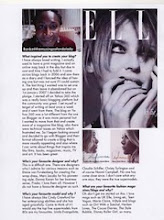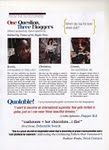 I have often viewed John Rankin aka Rankin to be a rather detached figure; from his input to uber trendy mag, Dazed & Confused to holding the position as one of the nation's coveted photographers. He has snapped everyone from The Spice Girls, Kate Moss, Naomi Campbell, Kylie Minogue, Queen Elizabeth and Tony Blair. Rankin has also had his fingers in other pies; a quick look at Wikipedia tells me that he is co-owner of the Proud Galleries and publishes Another Magazine and Another Man. So watching him gush over the work of veteran photographers in the documentary, Seven Photographs that Changed Fashion is very endearing. The programme paid homage to great photographers past and present and looked at iconic images in the history of fashion which you can see above. To add a twist to things Rankin recreated each photograph with his own team of stylists and make up artists as well as contemporary models. You can see the new Rankin versions below.
I have often viewed John Rankin aka Rankin to be a rather detached figure; from his input to uber trendy mag, Dazed & Confused to holding the position as one of the nation's coveted photographers. He has snapped everyone from The Spice Girls, Kate Moss, Naomi Campbell, Kylie Minogue, Queen Elizabeth and Tony Blair. Rankin has also had his fingers in other pies; a quick look at Wikipedia tells me that he is co-owner of the Proud Galleries and publishes Another Magazine and Another Man. So watching him gush over the work of veteran photographers in the documentary, Seven Photographs that Changed Fashion is very endearing. The programme paid homage to great photographers past and present and looked at iconic images in the history of fashion which you can see above. To add a twist to things Rankin recreated each photograph with his own team of stylists and make up artists as well as contemporary models. You can see the new Rankin versions below.
Cecil Beaton - the quintessential British photographer.
"He help set the template for fashion photography. Packaging a world of decadent beauty and above all selling a dream," says Rankin. He recreated the 1934 photo in Vogue that showed off a white Panama hat. "Beaton brought to it his typical wit and elegance so that what she is wearing is secondary to the beauty of the image." Rankin enlisted the service of pop star and model, Sophie Ellis Bextor to pose as the model as she was ideal for the 1930s and 1940s look.

Erwin Blumenfeld - the innovator and pioneer.
"Blumenfield was all about visual experimentation. He was an innovative fashion photographer of his era and a pioneer for colour photography. His stunning Vogue cover in 1950 shows the influence of the surrealist but also shows the excitement of the country looking forward to the next century," says Rankin. Heidi Klum was chosen to be the muse for this shot due to her chameleon tendencies and stardom.

Richard Avedon - the first celebrity fashion photographer.
"Classic styling with energy and creative spirit. Daring, stylish and ambitious, his pictures reflected the optimism of 50s America and turned him into the first celebrity fashion photographer. His status was confirmed by Funny Face, a film based on Avedon but was was made famous for starring Audrey Hepburn and Fred Astaire. His photo of a model with elephants that was in Harpers Bazaar in 1955," says Rankin. He chose supermodel, Erin O'Connor for the recreation because of her tall frame and demeanor.

David Bailey - the man who brought sex to photos.
"Before Bailey, fashion photographer in Britain was still a gentleman's trade however he broke through all that bringing an energy, charm and incredible life to his images. Bailey is the perfect fashion photographer combining technical brilliance with sheer force of personality to create photos that have a sense of total spontaneity. He created some of the most iconic images of the 60s and most of them were with his muse and girlfriend, Jean Shrimpton, " says Rankin. It is the image from Vogue in 1963 that Rankin chose to recreate with his own girlfriend, Tuuli Shipster.

Helmut Newton - the voyeur.
"In the era of sexual liberation, pornography going mainstream and conventions being challenged; Newton's voyeuristic images of strong women in often highly charged sexual scenarios often captured the new mood. His pictures also suggested that fashion photographs could be more than just a beautiful snapshot. His images felt like frames from a slightly seedy film and moved fashion photography forward again,' says Rankin. The photo that he recreated is the one taken for Vogue in 1975 with an androgynous and mysterious feel taken in the Rue Aubriot in Paris outside Newton's apartment. Rankin has gone back to the same street for his shoot and is using models, Jade Parfitt and Mollie Gondi.

Guy Bourdin - one of the most imitated fashion photographers of all.
"His highly saturated look and dramatic scenario seem to suggest some hidden tension or trauma. His influence is incredible not just in photography but in pop culture," says Rankin. He chose to recreate Bourdin's 1970 Vogue cover because it captures the sleazy glamour of his work with none of the admiration of women normally seen in traditional fashion photos. He invited model and socialite, Daphne Guinness to pose for the shot.

Herb Ritts - who brought homoeroticty into the mainstream.
"Ritts' work has been described as so dark you can see the shadows and the light. He wanted to make beautiful images with beautiful people and in doing so was responsible for the way men were portrayed in fashion. His image 'Fred With Tyres' which was about workers in denim was shown in Italian Vogue in 1984 and caused quite a stir," says Rankin. To recreate this image, Rankin invited top male model, David Gandy who is the face of Dolce and Gabanna.
I learnt a lot from this documentary, as well as what a passionate and dedicated photographer, Rankin is but also the enormous respect he has for his peers and craft. He even took one of the images in a digital format but still achieved the same effect. Seven Photographs That Changed Fashion has also given me a great introduction into the artists who made their mark in photography.
Images taken by the BBC.
























2 cool comments:
Oh I saw this prog. V good, I liked the Helmut Newton one and Sophie Ellis Bextor was just lovely! PS, This Twitter thing is mad, it's like entering a very crowded and buzzy party but not being able to have a chat because you will constantly be interrupted, LOL!
Mitic pictures!!!
Post a Comment